The enchanting allure of Japanese landscaping has captivated hearts around the world. Japan, with its profound connection to nature and a rich history of artistic expression, is synonymous with stunning gardens and parks that embody the essence of tranquility and beauty. Among the many cities that boast these natural wonders, Kanazawa, nestled in the Ishikawa Prefecture, stands out as a treasure trove of horticultural marvels.
📍 Located in the Ishikawa Prefecture, Kanazawa is a city that’s renowned for its traditional Japanese gardening. The city is home to several awe-inspiring gardens and parks that are well-preserved and open to the public. 🌿
🏯 Kanazawa’s Horticultural Legacy: Where Tradition Meets Nature
Kanazawa has earned its reputation as a city deeply rooted in the art of Japanese gardening. It is a living testament to the profound connection between humanity and the natural world. Within the confines of this charming city, you’ll encounter a collection of meticulously crafted gardens and parks. These aren’t just spaces of beauty; they are living embodiments of Japanese culture and heritage, offering visitors an opportunity to step into a world where time seems to stand still.
🌿 A Harmonious Blend of Nature and Culture
Kanazawa’s Gardens and Parks are a testament to the harmonious coexistence of nature and human creativity. Whether you find solace in the rustling leaves, the fragrance of blossoms, or the sense of peace that envelopes these spaces, each garden and park in Kanazawa is a unique tapestry woven from centuries of traditions. They cater to a diverse audience, from avid nature lovers seeking respite from the urban jungle to history enthusiasts eager to uncover the stories etched into the landscapes.
🏞️ Unveiling the Charms of Kanazawa
We invite you to join us on a virtual journey through Kanazawa’s Gardens and Parks in Japan in the upcoming posts. Together, we’ll delve deep into the world of traditional Japanese landscaping. Each garden and park carries its unique tale, and our mission is to decode the language of horticulture, revealing the cultural significance and profound beauty beneath the surface. Whether you’re planning a visit or simply wish to immerse yourself in the splendor of these landscapes, our exploration promises to be an enlightening and enchanting experience. 🌸🌿
So, stay tuned as we unlock the secrets of Kanazawa’s hidden gems, and let the beauty of Japanese gardening wash over your senses.
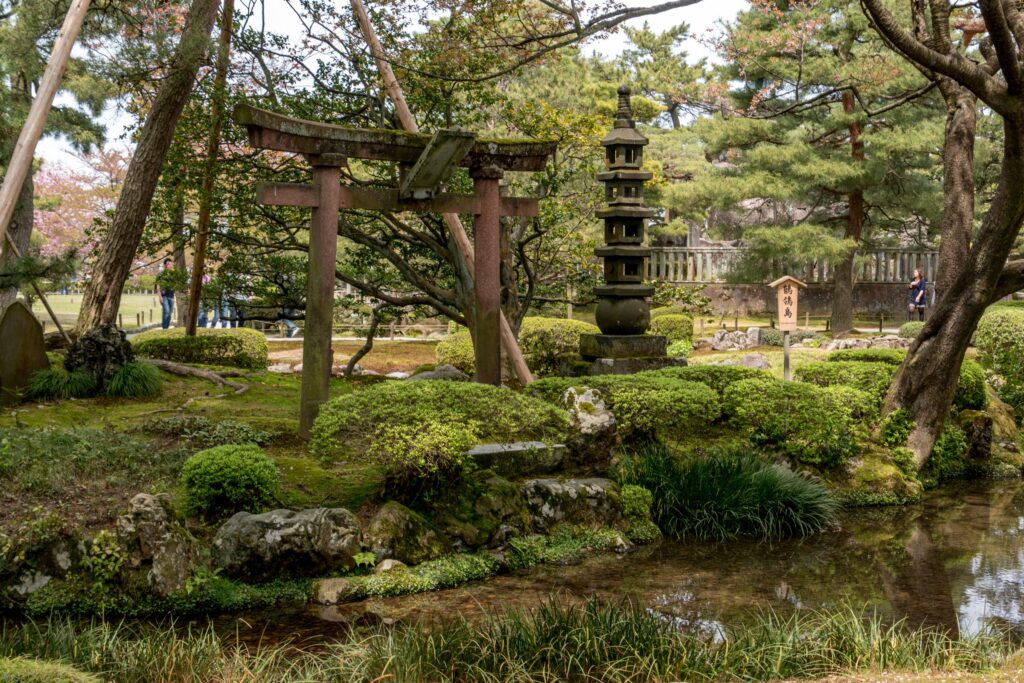
🌿 Discovering the Treasures Within Kanazawa’s Gardens and Parks
Nestled in the heart of Kanazawa lie some of Japan’s most captivating and historically significant gardens and parks. These natural wonders tell a unique tale, offering travelers a glimpse into the city’s rich past and its enduring love affair with nature. While exploring these enchanting landscapes, it becomes evident that they are not merely products of chance but deliberate creations born during the Edo period (1603-1868) under the patronage of the esteemed Maeda family.
🏯 The Maeda Family: Guardians of Kanazawa’s Natural Beauty
During the Edo period, the Maeda clan reigned as the daimyo (feudal lords) of Kaga Province, now known as Ishikawa Prefecture. Beyond their political influence and wealth, the Maeda family was renowned for their deep appreciation of the natural world. This profound connection to nature spurred them to craft the exquisite gardens and parks that continue to grace Kanazawa today.
🌸 The Gardens That Echo Through Time
Intricately designed, these gardens and parks served dual purposes. Firstly, they reflected the Maeda family’s affluence and societal standing, symbolizing their prestige. Secondly, they were spaces of profound beauty, where the rhythms of nature intertwined with human ingenuity. Today, these spaces are living testimonials to a bygone era, allowing modern travelers to step back in time and witness the convergence of art, culture, and nature.
🌲 Open Doors to Nature’s Splendor
As you embark on your journey through Kanazawa’s Gardens and Parks, you’ll find that each has a unique story. They beckon with the promise of tranquility, offering an escape from the bustle of urban life. For travelers, these natural sanctuaries are a glimpse into Japan’s horticultural heritage. They provide an opportunity to witness traditional Japanese landscaping at its finest, and through their meticulously manicured landscapes, they reveal the enduring beauty of nature as seen through the eyes of the Maeda family.
🏞️ A Journey Back in Time
Throughout this series, we’ll delve deep into the enchanting realms of Kanazawa’s Gardens and Parks. We’ll explore their rich history, discover the tales hidden among the stones and foliage, and unveil their design secrets. Whether you’re planning your visit to Kanazawa or simply wish to immerse yourself in the splendor of these landscapes from afar, our exploration promises to be an enlightening and engaging experience. 🌸🍃
So, as we prepare to unlock the gates to Kanazawa’s natural treasures, let the allure of traditional Japanese landscaping captivate your imagination and transport you to a world where the beauty of nature reigns supreme.
🌿 Mastering the Art: Japanese Landscaping Unveiled
The art of Japanese landscaping is a profound journey into the soul of nature itself. Creating a Japanese garden is a meticulous craft that involves blending natural elements to craft peaceful and harmonious environments. These gardens embody ancient traditions and serve as a serene refuge from the hustle and bustle of daily life. The guiding principles of harmony, simplicity, and asymmetry invite visitors to experience a peaceful and mystical atmosphere.
🍃 The Harmony of Elements: Rocks, Water, and Plants
In the canvas of a Japanese garden, rocks, water, and plants emerge as the artists’ tools. Each element carries its symbolic weight and purpose, contributing to the overall balance and grace of the landscape. Rocks, hewn into diverse shapes and sizes, symbolize the grandeur of mountains, while water in its meandering courses mirrors the gentle flow of streams and rivers. Evergreen and deciduous plants assume the roles of storytellers, narrating the passage of seasons and weaving a tapestry of color, fragrance, and life throughout the year.
🍁 An Intimate Dance of Design: The Changing Perspectives
One of the most enchanting facets of Japanese landscaping is its dynamic design. These gardens are not static canvases but living, breathing entities that evolve as you traverse. As you move through the areas, you’ll discover new views, hidden gems, and a sense of adventure. Whether strolling through a tranquil courtyard or gazing upon the mirrored surface of a picturesque pond, each step leads you deeper into a realm of unparalleled peace and tranquility.
🍂 A Spiritual Odyssey in Every Step
Beyond their aesthetic allure, Japanese gardens are repositories of ancient wisdom and spirituality. They invite you to embark on a spiritual journey as you meander their meticulously arranged paths. Every stone, every ripple in the water, every carefully pruned branch tells a story, offering glimpses into the cultural tapestry that gave birth to these landscapes. In each mossy stone and gracefully arching bridge, you’ll discover echoes of centuries of tradition and the enduring human desire to commune with nature.
🍁 The Promise of Serenity Awaits
As we continue our exploration of the art of Japanese landscaping in the gardens and parks of Kanazawa, allow yourself to be captivated by the essence of these tranquil spaces. Their designs are a testament to the profound connection between humanity and nature, where simplicity reigns supreme, asymmetry dances with harmony, and every element whispers ancient secrets of the land. 🌸🏞️
So, let the art of Japanese landscaping unfold before you, and may it inspire you to seek moments of serenity and contemplation in your own life, whether you’re strolling through these gardens in person or immersing yourself in their beauty from afar.
Notable Gardens and Parks in Kanazawa
Having immersed ourselves in the enchanting realm of Kenroku-en, we find ourselves compelled to embark on a captivating journey through the verdant tapestry of Kanazawa’s meticulously nurtured gardens and parks. Within the heart of this city, an unwavering commitment to the preservation and exultation of Mother Nature’s treasures resonates, transcending the boundaries of a solitary garden. Our exploration now leads us to unveil a vibrant array of horticultural masterpieces, each with a distinct allure collectively encapsulating Japan’s profound and enduring reverence for the natural world.
In this enchanting city, where time-honored traditions intermingle with modernity, we shall traverse a landscape adorned with blooming wonders and tranquil oases. Through this journey, we shall unravel the hidden narratives woven within these green sanctuaries, shedding light on the profound connections between Kanazawa’s past and present. Each garden and park we shall encounter boasts a unique narrative, be it a reflection of the city’s historical heritage, a tribute to its artistic and cultural prowess, or a testament to the harmony between humanity and the environment.
So, prepare to set forth on an expedition that will introduce you to the multi-faceted facets of Kanazawa’s green treasures, providing not only a glimpse into its horticultural splendor but also an opportunity to delve deeper into Japan’s age-old and unwavering adoration for the natural world. As we meander through these botanical wonderlands, we shall unveil the secrets hidden beneath the petals and leaves, inviting you to immerse yourself fully in the embrace of Kanazawa’s flourishing beauty.
🌸 Kenroku-en Garden: A Serene Masterpiece in the Heart of Kanazawa
In the heart of Kanazawa, a city renowned for its exquisite gardens, the Kenroku-en Garden is a true gem among gems. With origins tracing back to the Edo period and an intimate connection to the neighboring Kanazawa Castle, this glorious garden extends its embrace across 11.4 hectares of pure beauty.
Discovering Kanazawa’s Horticultural Heart
Kanazawa, often called “Little Kyoto,” boasts a rich cultural heritage and is celebrated for preserving traditional Japanese arts. Among its many treasures, the Kenroku-en Garden stands out as a horticultural masterpiece. Established over three centuries ago during the Edo period by the ruling Maeda family, this garden has earned its place among Japan’s top three most beautiful gardens.
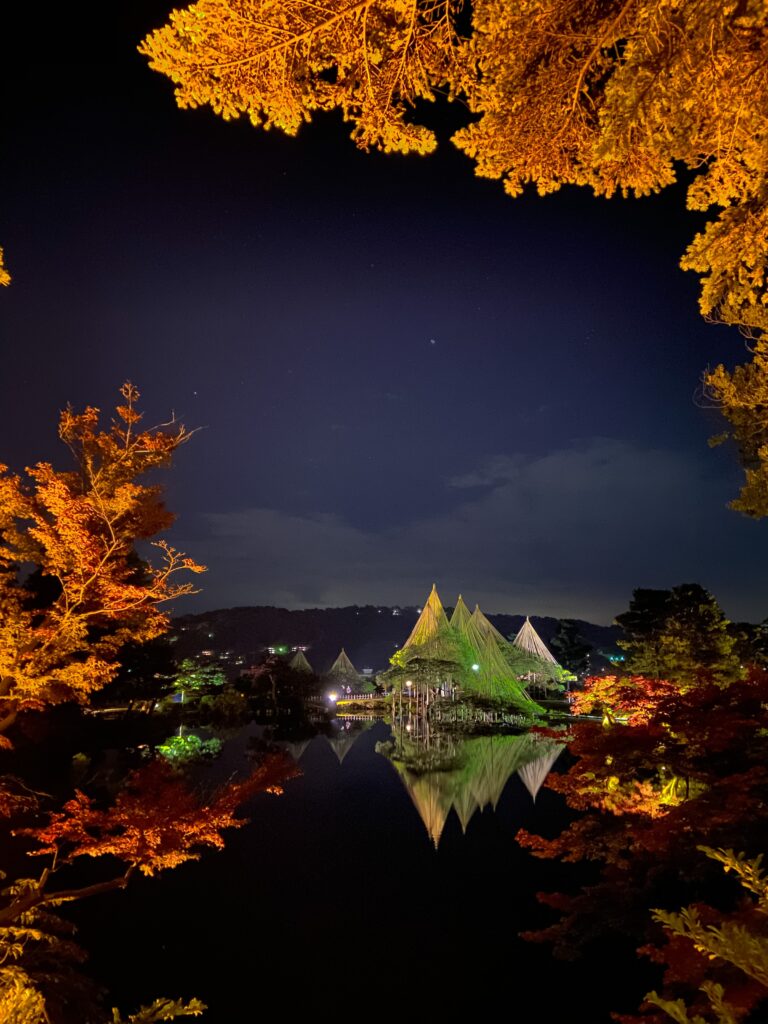
A Historic Tapestry Unfolds
As you step into Kenroku-en, you return in time, entering a world where history, culture, and nature intertwine. The location of Kenroku-en is of great significance due to its proximity to Kanazawa Castle, a symbol of power and refinement during Japan’s feudal era. The Maeda family, who governed the region, established this magnificent garden in the 17th century to showcase their love for nature and prestige. In doing so, they gifted Kanazawa, indeed the world, with a place of astounding beauty that has transcended the centuries.
A Seasonal Symphony
Throughout the year, Kenroku-en undergoes a mesmerizing transformation with each season. In spring, cherry blossoms adorn the landscape, casting a delicate pink hue over the garden’s serene ponds and enchanting bridges. Summer brings lush greenery and the soothing sound of water trickling through the garden’s streams. Fall sets the garden ablaze with the fiery colors of maple leaves, while winter blankets it in serene stillness, with delicate snowflakes adding a touch of magic. These seasonal changes make each visit to Kenroku-en a unique experience, inviting you to return throughout the year and witness its ever-shifting beauty.
Exploring the Garden’s Treasures
Kenroku-en is a place of discovery and wonder. As you wander its meticulously designed paths, you’ll encounter an array of captivating features, including the iconic Kotoji-toro stone lantern, graceful teahouses where you can savor matcha tea, and vantage points that offer breathtaking views of the garden’s landscape. The shimmering Kasumiga-ike pond, reflecting the surrounding greenery and the iconic Yamazaki-yama hill, is a remarkably tranquil spot, perfect for contemplation and photography.
A Garden of Endless Delights
Intricate landscaping elements are woven throughout the garden, embodying the principles of harmony, simplicity, and asymmetry central to traditional Japanese garden design. These elements include stone pathways, carefully pruned trees, and meticulously placed rocks, all working in concert to create an atmosphere of serenity and balance. The gentle gurgle of water, birds chirping, and leaves rustling in the breeze provide a soothing symphony that enhances your immersion in this natural haven.
A Timeless Beauty
The Kenroku-en Garden is not merely a historical relic but a living work of art that continues to evolve with the seasons and the passing of time. Its enduring allure has earned it a spot on Japan’s Special Historical Sites list and as a designated Cultural Asset. Whether you’re a nature enthusiast, a history buff, or someone seeking tranquility amidst exquisite surroundings, Kenroku-en welcomes you to explore its timeless beauty and discover the profound connection between nature, culture, and history that defines this magnificent garden.
Wandering the Historic Garden Pathways
To fully appreciate Kenroku-en, exploring its network of carefully designed pathways is essential. These paths, known as “roji,” lead you through various aspects of the garden, allowing you to experience its diverse features up close. Each turn in the pathway reveals a new vista, a hidden treasure, or a perfect spot for contemplation.
The Iconic Kotoji-toro
One of the most famous features of Kenroku-en is the Kotoji-toro stone lantern, an iconic symbol of both the garden and Kanazawa itself. This two-legged lantern stands at the edge of Kasumiga-ike pond, creating a stunning reflection in the water. It’s a sight that encapsulates the harmony and beauty of traditional Japanese landscaping. The lantern is enchanting during the evening illumination events held periodically throughout the year.
Sipping Tranquility at Teahouses
Traditional Japanese gardens often incorporate teahouses, and Kenroku-en is no exception. Within the park, you’ll find several charming teahouses where you can partake in the revered Japanese tea ceremony. Sipping matcha tea while surrounded by the garden’s beauty is a transcendent experience, offering a deeper connection to the spirit of the Edo period.
A View from the Top
For panoramic views of Kenroku-en and the surrounding landscape, make your way to the iconic Yamazaki-yama hill. Follow the stone path that leads to the summit and be amazed by the breathtaking vistas that stretch far beyond the garden to the beautiful city of Kanazawa. It’s a perfect spot for photographs and a moment of reflection on this remarkable garden’s beauty and historical significance.
Embracing the Seasons
Kenroku-en’s beauty is not static but ever-changing with the seasons. The garden bursts to life in spring with cherry blossoms, creating a breathtaking canopy of pink and white blooms. Summer brings lush greenery and the serene sound of water flowing through the garden’s streams and ponds. In autumn, the landscape blazes with fiery hues as maple leaves change color, creating a vivid contrast to the deep green of the pines. Even in winter, the garden holds its unique charm, with delicate snowfall lending an air of tranquility to its scenery.
Kenroku-en at Night
To witness Kenroku-en in a different light, consider visiting during one of its evening illumination events. The garden has a magical aura as lanterns and lights accentuate its features. It’s a time when enchantment accompanies the garden’s serene beauty.
Kenroku-en: A Living Work of Art
In a world where time rushes forward, Kenroku-en is a testament to the enduring beauty of nature and human creativity. Its meticulously crafted landscapes, teahouses steeped in history, and iconic features like the Kotoji-toro lantern create an experience that transports you to another era.
A Place of Tranquility and Inspiration
Visiting Kenroku-en is not just a stroll through a garden; it’s a journey through history, culture, and the changing seasons. It’s a place where the artistry of nature and humanity meld into a harmonious whole, leaving you with a profound sense of tranquility and inspiration. Whether you’re a seasoned traveler or a first-time visitor to Japan, Kenroku-en is a destination that promises an unforgettable experience.
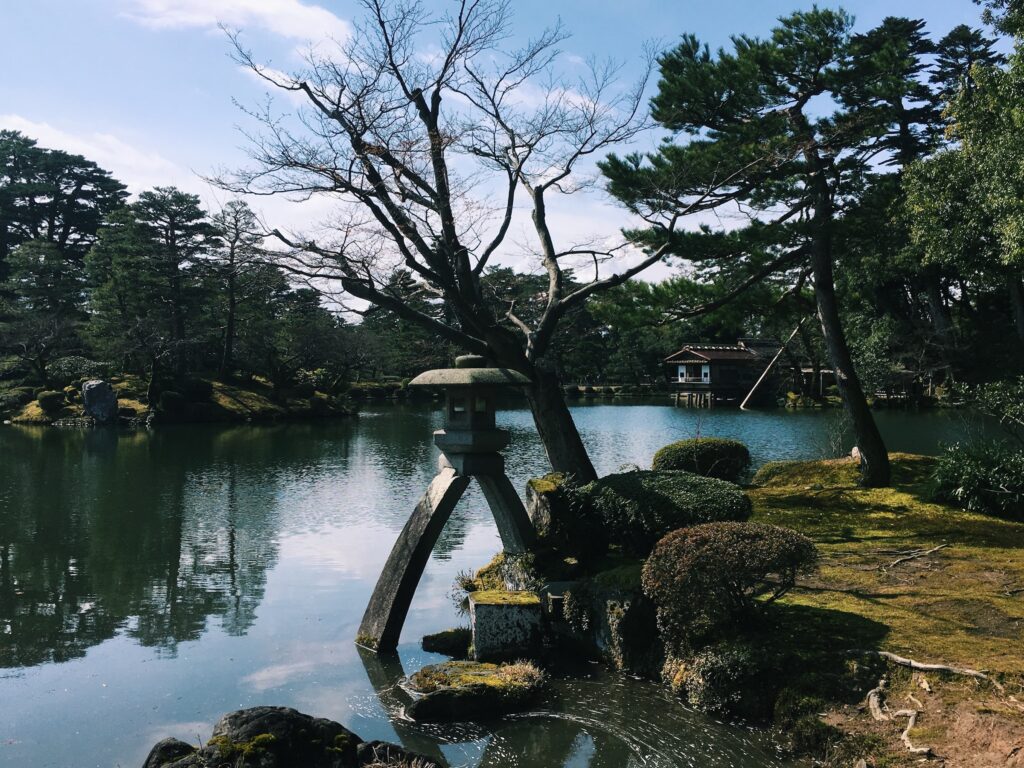
Kanazawa Castle Park: Where History Blooms
Nestled at the heart of Kanazawa lies a sprawling oasis of history and natural beauty – Kanazawa Castle Park. This magnificent park, crafted during the illustrious Edo period, unfurls its verdant tapestry across an expansive 26.6 hectares, offering visitors a mesmerizing blend of heritage and horticulture. At its heart stands Kanazawa Castle, a venerable monument to the city’s rich past, constructed in 1583 to serve as the formidable seat of power for the Maeda family.
A Sanctuary of Tranquility
Kanazawa Castle Park is a sanctuary, an escape from the urban hustle and bustle into a realm where time seems to slow and history whispers through the leaves. The park’s meticulously planned landscape, complete with serene ponds, winding pathways, and exquisite flora, invites you to embark on a journey through centuries. As you explore, each step is a step into the past, a connection to the Maeda lords who once walked these grounds.
Kanazawa Castle: A Bastion of Legacy
At the heart of this park stands Kanazawa Castle, a true bastion of legacy. Its imposing presence and majestic architecture serve as a visual testament to the power and prestige of the Maeda family during Japan’s feudal era. The castle’s distinctive white walls, gracefully sloping roofs, and intricate woodwork are a sight to behold, reflecting the architectural marvels of its time.
Seasons of Splendor
Kanazawa Castle Park boasts a breathtaking spectacle all year round. During springtime, the park becomes a paradise adorned with a cascade of cherry blossoms. The picturesque landscape is transformed into a sea of delicate pink and white hues, providing a serene and peaceful ambiance for visitors to enjoy. Autumn sets the trees ablaze with fiery shades of red and gold, while winter cloaks the park in quiet tranquility, blanketing it under a pristine snow cover.
Exploring the Past
As you meander through Kanazawa Castle Park, history comes to life. The preserved structures, gates, and walls tell stories of a bygone era, where samurai once roamed and strategy-shaped destinies. With its elegant design and imposing stature, the Ishikawa-mon Gate stands as a symbol of the castle’s historical significance.
A Journey Through Time
Kanazawa Castle Park is not just a place to admire; it’s a journey through time. It’s an opportunity to immerse yourself in Japan’s storied past, to imagine the lives of lords and ladies who walked these gardens, and to appreciate the architectural brilliance of the era. As you explore the park, you’ll find that every stone, every tree, and every structure has a story to tell, weaving a tapestry of history that transcends centuries.
Planning Your Visit
When planning your visit to Kanazawa Castle Park, consider the time of year that most resonates with you. Each season offers a different perspective on the park’s beauty. Whether you’re captivated by the ephemeral beauty of cherry blossoms, the lushness of summer, the fiery spectacle of autumn foliage, or the serenity of winter’s embrace, Kanazawa Castle Park promises a captivating experience year-round.
Kanazawa Castle Park is not just a park; it’s a living heritage, a testament to Kanazawa’s dedication to preserving its past and celebrating its natural beauty. It’s where history and horticulture intertwine harmoniously, inviting you to embark on a journey through time. Whether you’re a history buff, a nature enthusiast, or simply seeking moments of tranquility, this park beckons you to explore its wonders, creating memories that will linger long after you’ve left its enchanting embrace.
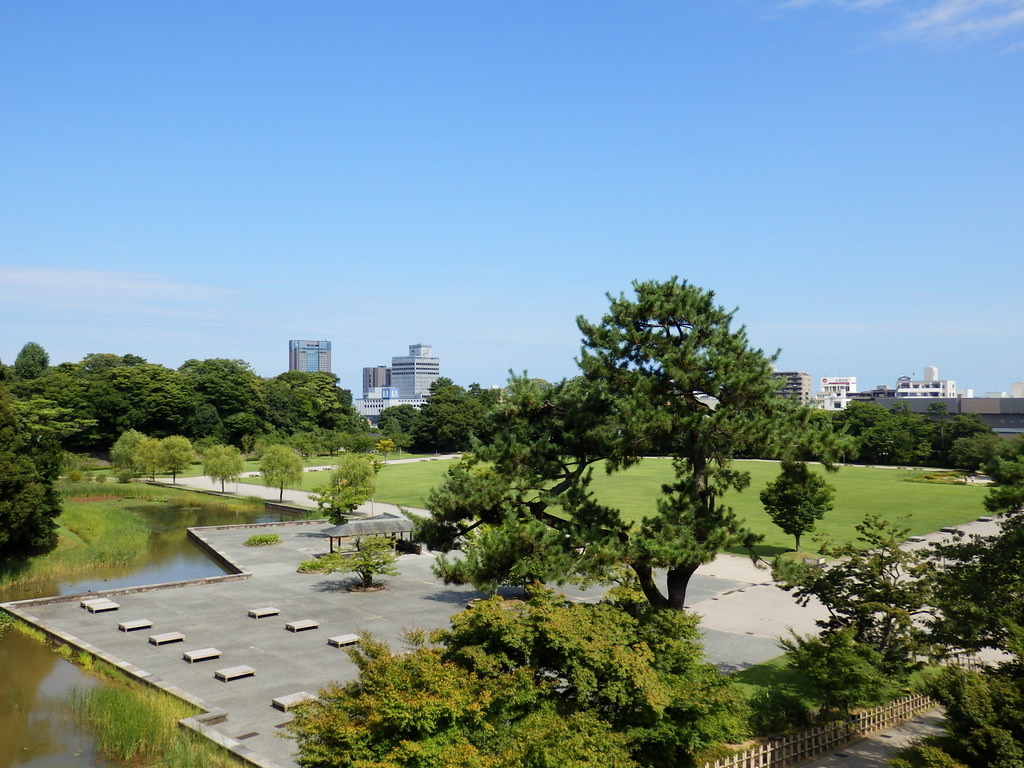
Gyokusen-in Maru Garden: Where Tranquility Finds Its True Home
Nestled within the heart of Kanazawa Castle Park lies a serene haven, a respite from the clamor of urban life – the Gyokusen-inmaru Garden. This exquisite garden, born during the Edo period, offers a glimpse into the intricate artistry of traditional Japanese landscaping, where nature harmoniously coexists with human design and tranquility finds its true home.
A Mirror of Serenity: The Carp Pond
One of the crown jewels of Gyokusen-inmaru Garden is its tranquil pond, a mirror reflecting the garden’s very soul. This shimmering expanse of water creates a serene centerpiece where nature and design elements elegantly merge. A graceful carp community finds its home here, gliding effortlessly through the crystal-clear waters. Their vibrant presence adds a touch of life and color to the garden’s serene ambiance. You’ll be captivated by their grace as you stand by the pond’s edge and watch these elegant creatures dance beneath the water’s surface. It’s a moment of connection with the living heart of the garden, where the ancient art of Japanese landscaping meets the vitality of nature.
A Symphony of Nature and Design
Gyokusen-inmaru Garden weaves a delicate tapestry of traditional Japanese landscaping elements. Every stone, every water feature, and every meticulously selected plant plays a role in creating a symphony of nature and design. The garden’s layout, carefully conceived during the Edo period, leads you on a journey of discovery. As you explore its winding paths, you’ll encounter moments of profound serenity, where the gentle babble of water harmonizes with the rustling leaves, and the play of light and shadow creates a mesmerizing interplay. The entire landscape becomes a work of art, a canvas where man’s hand and the touch of nature collaborate to tell a story of timeless beauty.
Strolling Through Serenity
As you meander through Gyokusen-inmaru Garden, each step becomes a conversation with nature. Vibrant greenery envelops you, creating a sense of calm and tranquility. The placement of rocks thoughtfully positioned guides your gaze and invites contemplation. Every element is in harmony, a testament to the enduring artistry of traditional Japanese gardening. You’ll discover hidden corners where stone lanterns glow warmly upon moss-covered paths, and the subtle perfume of blossoms fills the air. It’s an environment that encourages mindfulness, where the world’s cares seem to melt away, leaving only the moment’s beauty.
A Hidden Gem Awaits
Gyokusen-inmaru Garden is not just a garden; it’s an oasis of serenity hidden within Kanazawa Castle Park. It’s a place where time stands still, and the world’s cares fade away. Whether you’re a nature lover seeking the company of carp in the tranquil pond, an admirer of meticulous design, or simply a wanderer searching for beauty in its purest form, this garden welcomes you with open arms. It’s a hidden gem waiting to be discovered, a refuge from the noise of modern life, and a testament to the enduring allure of Japanese landscaping.
A Must-Visit Destination
When you visit Kanazawa, don’t let Gyokusen-inmaru Garden remain a hidden treasure. It’s a must-visit destination for those seeking tranquility and natural beauty. Take your time to explore its nooks and crannies, admire its thoughtful design, and immerse yourself in the timeless art of Japanese landscaping. Gyokusen-inmaru Garden promises a serene experience, a pause in your journey where peace and nature converge in perfect harmony. It’s an invitation to slow down, breathe deeply, and appreciate the beauty surrounding us – an experience that transcends time and leaves an indelible mark on the soul.
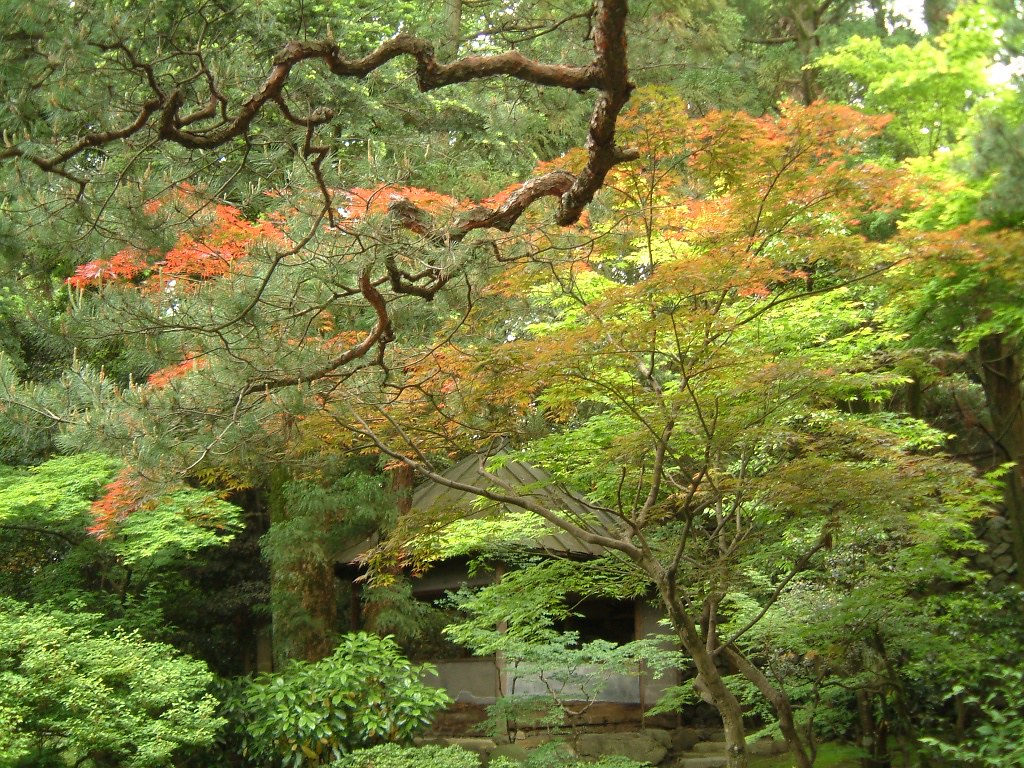
Seisonkaku Villa: Where Cultures Unite in Natural Harmony
Nestled within the heart of Kanazawa, the Seisonkaku Villa stands as a testament to cultural fusion and timeless beauty. Seisonkaku Villa’s harmonious blend of traditional Japanese and Western architectural styles makes it remarkable, creating a tapestry of cultural influences that extends to its stunning gardens.
A Meeting of East and West: The Architectural Symphony
At Seisonkaku Villa, cultures converge and coalesce in architectural splendor. The villa’s design is a testament to the openness of the late Edo period when Japan embraced Western influences. You’ll discover a seamless fusion of traditional Japanese aesthetics and Western architectural elements. Western-style rooms with intricately adorned ceilings and elegant furnishings stand in dialogue with the graceful simplicity of Japanese tatami rooms. While walking through the villa’s halls, you’ll experience a unique fusion of cultures and artistic experimentation.
The Gardens of Seisonkaku: A Fusion of Styles
The gardens that grace Seisonkaku Villa are a living testament to cultural harmony. Japanese and Western landscaping elements intertwine, creating a unique and captivating atmosphere. A picturesque pond takes center stage, adorned with a Western-style bridge that adds a touch of European elegance. This Japanese-style garden features meticulously manicured plants surrounding a traditional tea house, creating a serene atmosphere that beautifully contrasts with the adjacent area.
A Journey Through Time and Culture
Visiting Seisonkaku Villa is not merely a stroll through a historic residence; it’s a journey through time and culture. The villa’s architectural and garden design offers a glimpse into a period of cultural exchange when Japan was opening its doors to the world. The Western influence in the villa’s design reflects an era of transformation and adaptation.
Exploring the Blend of Traditions
As you explore the villa and its gardens, you’ll immerse yourself in a blend of traditions. You can appreciate the intricate details of Western-style rooms while marveling at the tranquility of Japanese gardens. Each step invites reflection on the passage of time and the interconnectedness of cultures.
A Cultural Tapestry Awaits
Seisonkaku Villa stands as a testament to the enduring beauty of cultural fusion. It’s where the East meets the West, where architectural styles mingle, and gardens reflect the harmony between traditions. Whether you’re an architecture enthusiast, a history lover, or someone seeking a moment of serenity amidst a rich cultural tapestry, Seisonkaku Villa welcomes you with open doors.
An Unforgettable Experience
When you visit Kanazawa, don’t miss the opportunity to step into the past and witness the elegance of Seisonkaku Villa. It’s an experience transcending time and place, offering a glimpse into a world where cultures converged, and artistic expressions knew no bounds. It’s a testament to the enduring power of beauty and cultural exchange – an experience that will leave an indelible mark on your journey through Kanazawa’s rich history.
Myoryu-ji Temple Garden (Ninja Temple): Unraveling Secrets in Nature’s Embrace
In the heart of Kanazawa, amidst the serenity of nature, lies a unique and enigmatic attraction – the Myoryu-ji Temple, fondly known as the “Ninja Temple.” While this temple offers a captivating glimpse into the clandestine world of ninja history, its exquisite garden’s hidden gem truly enchants visitors.
A Garden Shrouded in Mystery
Myoryu-ji Temple’s garden is no ordinary green space; it’s a landscape that conceals secrets and weaves tales of intrigue. As you step into this garden, you’ll find yourself enveloped by lush greenery, where meticulously manicured plants create a sense of tranquility. Yet, it’s not just the beauty that captivates; it’s the temple’s ingenious design.
Hidden Passageways and Surveillance Windows
The garden at Myoryu-ji Temple is more than meets the eye. Cleverly integrated into its design are hidden passageways and strategically placed windows. These architectural marvels served a dual purpose in the temple’s history. On one hand, they provided an element of surprise and defense, characteristic of the ninja ethos. On the other, they allowed for efficient surveillance of the temple grounds, a testament to the meticulous planning that went into its creation.
A Glimpse into Ninja History
While the garden is a testament to architectural ingenuity and landscaping artistry, it’s essential to remember that Myoryu-ji Temple is often called the “Ninja Temple” for a reason. As you explore its garden, you’re also delving into the world of ninja history. Though now peaceful, the hidden passageways and surveillance windows once harbored the secrets and strategies of these enigmatic figures.
Tranquility Amidst Intrigue
As you wander through Myoryu-ji Temple’s garden, you’ll experience tranquility and intrigue. The beauty of nature combines seamlessly with the temple’s history, inviting reflection on the juxtaposition of peace and conflict, serenity, and espionage.
A Must-Visit in Kanazawa
For those seeking a truly unique and thought-provoking experience in Kanazawa, the Myoryu-ji Temple Garden is a must-visit. It’s a place where the serenity of nature conceals the echoes of a mysterious past, where beauty and enigma harmonize, and where the allure of ninja history merges with the elegance of Japanese landscaping.
Unlocking the Secrets of Myoryu-ji Temple
Intriguing, captivating, and shrouded in history, Myoryu-ji Temple’s garden is where nature’s beauty and human ingenuity come together. It’s an opportunity to unravel the secrets of the past while immersing yourself in the tranquility of the present. As you visit this remarkable attraction, you’ll embark on a journey through time and culture, leaving you with memories that are as enchanting as they are thought-provoking.
Shinzengumi Memorial Park: Where Samurai History Blooms
Visiting Shinzengumi Memorial Park in Kanazawa is essential for those profoundly appreciating history. This park is a poignant tribute to the Shinzengumi, a legendary samurai group that left an indelible mark on Japan’s history. Here, amidst the serene setting, you’ll discover statues, plaques, and stories that breathe life into the tales of these remarkable warriors.
A Glimpse into Samurai Valor
The Shinzengumi, a band of masterless samurai during the turbulent Bakumatsu period, were known for their unwavering loyalty and commitment. As you stroll through the park, you’ll encounter statues that capture the essence of these brave warriors, offering a visual narrative of their courage and dedication.
Cherry Blossoms and Samurai Spirit
While the Shinzengumi Memorial Park is historically significant throughout the year, it takes on an added layer of enchantment during the spring season. As the cherry blossom trees bloom, the park transforms into a sea of delicate pink petals. Underneath this floral canopy, the spirit of the samurai comes alive, and visitors can immerse themselves in the beauty of nature and history.
Reflection and Reverence
As you explore this park, take a moment to reflect on the significance of the Shinzengumi in Japanese history. Their display of exceptional bravery and altruism has made an indelible mark on Japan. Its tranquil surroundings offer a space for reverence, allowing you to pay your respects to these remarkable samurai.
A Seasonal Delight
During the season of cherry blossoms, you will experience a delightful awakening of your senses. The park’s pathways become adorned with petals, creating an almost dreamlike atmosphere. It’s a time when history and nature intertwine, offering a unique and memorable experience.
A Journey into the Past
Shinzengumi Memorial Park is not just a place; it’s a journey into Japan’s storied past. It’s a reminder of the courage and honor that defined the samurai and an opportunity to connect with history profoundly. Whether you’re a history enthusiast or simply seeking the beauty of cherry blossoms in bloom, this park offers a space where the past and present harmoniously coexist.
An Invitation to Explore
For history enthusiasts and nature lovers alike, Shinzengumi Memorial Park extends an invitation to explore, learn, and appreciate the convergence of two remarkable facets of Japanese culture. It’s a place where the legacy of the samurai is honored and where the fleeting beauty of cherry blossoms reminds us of the transient nature of life itself.
Ishikawa Prefectural Park: A Contemporary Haven of Recreation
In the heart of Kanazawa, amidst the rich tapestry of traditional gardens and historic sites, the Ishikawa Prefectural Park is a testament to modern leisure and recreation. Unlike the serene tranquility of the city’s classical gardens, this park offers a more contemporary atmosphere, perfect for picnics, sports enthusiasts, and those seeking strolls amidst expansive greenery.
A Playground for All Ages
As you step into the Ishikawa Prefectural Park, you’ll immediately sense the vibrant energy that pulses through its grounds. This park is designed for everyone, making it a favored destination for families and active individuals. Here, you’ll find a playground where children’s laughter fills the air, while nearby, sports facilities beckon enthusiasts to engage in friendly matches.
Picnic Perfect
One of the park’s most cherished activities is picnicking. Spread a blanket on the spacious lawns and enjoy a relaxing meal amidst nature’s embrace. As you savor your bento or local delicacies, you’ll feel a sense of serenity that only a well-maintained urban park can provide.
Leisurely Strolls
If you prefer a more leisurely experience, the park’s walking trails offer a chance to reconnect with nature. Whether wandering solo, hand in hand with a loved one, or leading a furry friend, the pathways meander through carefully landscaped gardens, providing a moment of respite from the city’s hustle and bustle.
Seasonal Splendor
Throughout the year, the Ishikawa Prefectural Park undergoes its seasonal transformations. In spring, cherry blossoms bloom, painting the park in hues of delicate pink. Summer brings lush green foliage, while autumn leaves the trees with fiery hues. Even in winter, the park’s peaceful ambiance makes it ideal for a brisk walk on a crisp day.
A Modern Retreat
Amid a city celebrating tradition and history, the Ishikawa Prefectural Park offers a modern retreat. It’s a place where families create cherished memories, sports enthusiasts engage in friendly competition, and individuals find solace in the simple act of strolling through nature.
A Balance of Past and Present
As you explore Kanazawa, you’ll discover it’s a city of contrasts, seamlessly blending the past and the present. The Ishikawa Prefectural Park is a shining example of this harmony, where contemporary recreation coexists with the timeless beauty of the surrounding gardens and historical landmarks.
An Invitation to Enjoy
Whether you’re seeking an active day outdoors, a place for family fun, or a serene escape from the urban clamor, the Ishikawa Prefectural Park extends an invitation to enjoy its modern amenities and natural beauty. It’s a place where locals and visitors come together to celebrate life’s simple pleasures, reminding us that amidst the rush of daily life, moments of leisure and connection with nature are genuinely priceless.
Honda Forest: A Wilderness Oasis on Kanazawa’s Outskirts
While Kanazawa city boasts an array of meticulously designed gardens and urban parks, sometimes the call of the wild is impossible to resist. For those yearning for a deeper communion with nature, a visit to the Honda Forest on the outskirts of Kanazawa is an opportunity to immerse yourself in the serene embrace of unspoiled wilderness.
A Verdant Sanctuary
The Honda Forest is a vast woodland sanctuary that extends a warm invitation to those seeking natural respite. This vast, untouched forest exemplifies Japan’s woodland.
Trails to Tranquility
As you venture into the forest, you’ll discover a network of trails that wind their way through the ancient trees. Each step is a step into a realm where the scent of earth and leaves fills the air, dappled sunlight plays upon the forest floor, and the symphony of bird calls serenades your journey.
Ponds and Streams
One of the forest’s most enchanting features is its serene ponds and crystal-clear streams. These natural water bodies add to the forest’s charm and provide an opportunity for moments of quiet reflection. As you explore this untouched paradise, the gentle rustling of leaves and the murmur of flowing water become your companions.
A Haven for Birdwatchers
Honda Forest is a haven for birdwatchers. The diversity of birdlife here is a testament to the forest’s health and vitality. Keen observers can spot avian species amidst the branches, from vibrant songbirds to majestic raptors. Don’t forget your binoculars; you never know what feathered treasures await your discovery.
Hiking Adventures
For hiking enthusiasts, Honda Forest offers a range of trails that cater to various fitness levels. Whether you’re seeking a stroll or a more challenging hike, there’s a path for you. These trails provide an opportunity to witness the ever-changing beauty of the forest throughout the seasons, from the vibrant blooms of spring to the rich tapestry of autumn foliage.
A Place of Connection
In a world that often feels disconnected from the natural rhythms of life, Honda Forest beckons as a place of connection. Here, amid the ancient trees and the songs of wildlife, you can rekindle your bond with the earth. It’s a reminder that, no matter how busy life becomes, there’s always a place where you can retreat to find solace and restoration.
A Symphony of Seasons
Like all of nature, Honda Forest undergoes a symphony of changes with each passing season. During springtime, the forest floor is beautifully adorned with delicate wildflowers, creating a stunning natural carpet. Summer brings lush foliage, providing shade for your outdoor adventures. Autumn sets the trees ablaze with fiery colors, and even in winter, the forest’s quiet beauty is enchanting.
A True Wilderness Escape
The Honda Forest is a true wilderness escape on the outskirts of Kanazawa. It’s a place to unplug from the demands of the modern world and reconnect with the timeless rhythms of nature. Whether you’re an avid hiker, a birdwatching enthusiast, or simply someone searching for tranquility, this forest sanctuary offers a respite from the ordinary and an immersion into the extraordinary world of the wild.
Tips for a Blissful Visit to Kanazawa’s Gardens and Parks
Exploring Kanazawa’s gardens and parks promises a serene and enchanting experience. To make the most of your visit, consider these tips:
1. Comfortable Footwear: Kanazawa’s gardens often involve walking on gravel paths and stepping stones. Opt for comfortable, sturdy footwear to navigate these surfaces with ease.
2. Timing Matters: Different seasons offer unique experiences. Spring brings cherry blossoms, while autumn showcases vibrant foliage. Consider the time of year that aligns with your preferences.
3. Early Bird Advantage: Arriving early in the day allows you to enjoy the gardens with fewer crowds, providing a more tranquil atmosphere for reflection and photography.
4. Photography Etiquette: While the gardens are incredibly photogenic, be mindful of other visitors. Avoid blocking paths or disturbing the peaceful ambiance with loud camera equipment.
5. Tea House Delights: Many gardens feature traditional tea houses where you can savor matcha tea and seasonal sweets. Take a break and immerse yourself in this quintessential Japanese experience.
6. Guided Tours: Some gardens offer guided tours in English. These tours provide fascinating insights into the garden’s history and design.
7. Rainy-Day Visits: Don’t let rain deter you. Japanese gardens often take on a mystical quality in the rain, with glistening droplets on leaves and reflections in puddles.
8. Cash and Tickets: Some gardens may only accept cash for entry fees, so it’s wise to carry some yen. Check if there are any combination tickets if you plan to visit multiple gardens.
9. Learn Basic Phrases: While many staff may speak English, learning a few basic Japanese phrases can enhance your experience and show respect for the local culture.
10. Patience and Serenity: Lastly, remember that these gardens are designed for contemplation and serenity. Allow yourself to slow down, breathe in the beauty, and embrace the tranquility that these spaces offer.
With these tips in mind, your journey through Kanazawa’s gardens and parks will be a memorable and peaceful adventure. Enjoy the natural beauty and cultural richness that these places have to offer.
Kanazawa's Gardens and Parks offer a glimpse into traditional Japanese landscaping and are a must-visit for anyone traveling to Japan. These gardens and parks provide a unique blend of nature and architecture; visitors can experience the beauty of traditional Japanese landscaping at its finest.
Q&A: Exploring Kanazawa’s Gardens and Parks
Q1: When is the best time to visit Kanazawa’s gardens and parks?
- A1: The best time to visit depends on your preferences. Spring brings cherry blossoms, while autumn offers vibrant foliage. Consider your favorite season for outdoor exploration.
Q2: Are there any traditional tea houses in these gardens?
- A2: Yes, many gardens in Kanazawa have traditional tea houses. They offer matcha tea and seasonal sweets, providing a quintessential Japanese experience.
Q3: What should I wear when visiting these gardens?
- A3: Wear comfortable, sturdy footwear, as gardens often have gravel paths and stepping stones. Dress appropriately for the season, and consider layers for varying weather.
Q4: Can I join guided tours to learn more about the gardens?
- A4: Yes, some gardens offer guided tours in English. These tours provide fascinating insights into the history and design of the garden.
Q5: What if it rains on the day of my visit?
- A5: Rain can create a mystical atmosphere in Japanese gardens. Don’t be deterred; bring an umbrella and enjoy the unique beauty of the gardens in the rain.
Q6: Are there any etiquette rules for photography in these gardens?
- A6: While photography is encouraged, be mindful of other visitors. Avoid blocking paths and maintain a respectful noise level, especially near quiet areas.
Q7: Can I use credit cards for entry fees and purchases within the gardens?
- A7: It’s advisable to carry cash, as some gardens may only accept yen for entry fees. Check if there are combination tickets if you plan to visit multiple gardens.
Q8: Are these gardens suitable for families with children?
- A8: Yes, many gardens have open spaces, playgrounds, and scenic spots that families can enjoy. Some even host family-friendly events.
Q9: Do I need to book tickets in advance for these gardens?
- A9: Most gardens allow on-the-spot ticket purchases. However, during peak seasons, it might be wise to check if advance bookings are available.
Q10: How can I learn basic Japanese phrases to enhance my visit?
- A10: There are many language learning apps and websites that offer basic Japanese phrases and pronunciation guides. Learning a few phrases can enhance your experience and show respect for the local culture.
🌸🌳 If you’re looking for a peaceful retreat from the hustle and bustle of city life, Kanazawa’s Gardens and Parks are just what you need! With their stunning landscapes, tranquil ponds, and traditional Japanese designs, these gardens and parks offer an unforgettable experience for nature lovers and architecture enthusiasts alike. So, what are you waiting for? Put on your comfortable shoes, grab your camera, and get ready to immerse yourself in the breathtaking beauty of Kanazawa’s Gardens and Parks! 📷👟🌺
Do not forget to follow us on Instagram @sakurachroniclesblog 📷🌺
- The Best Waterfalls in Kyushu: Enjoying the Island’s Natural Beauty
- The Best Parks in Tokyo That Will Amaze You
- “Top of the World: Mystical Summit Experience Of Mount Fuji”
- “Kumamoto Serenity: Unmasking The Secrets Of Its Natural Wonders”
- The Best Beach Resorts in Shikoku
Kenrokuen Garden | Ishikawa Attractions | Travel Japan | JNTO
Kanazawa Castle Park (pref.ishikawa.jp)
SEISONKAKU – Villa for the wife of one of the Maeda lords
Gyokusen’inmaru Garden | Kanazawa Castle Park (pref.ishikawa.jp)

















